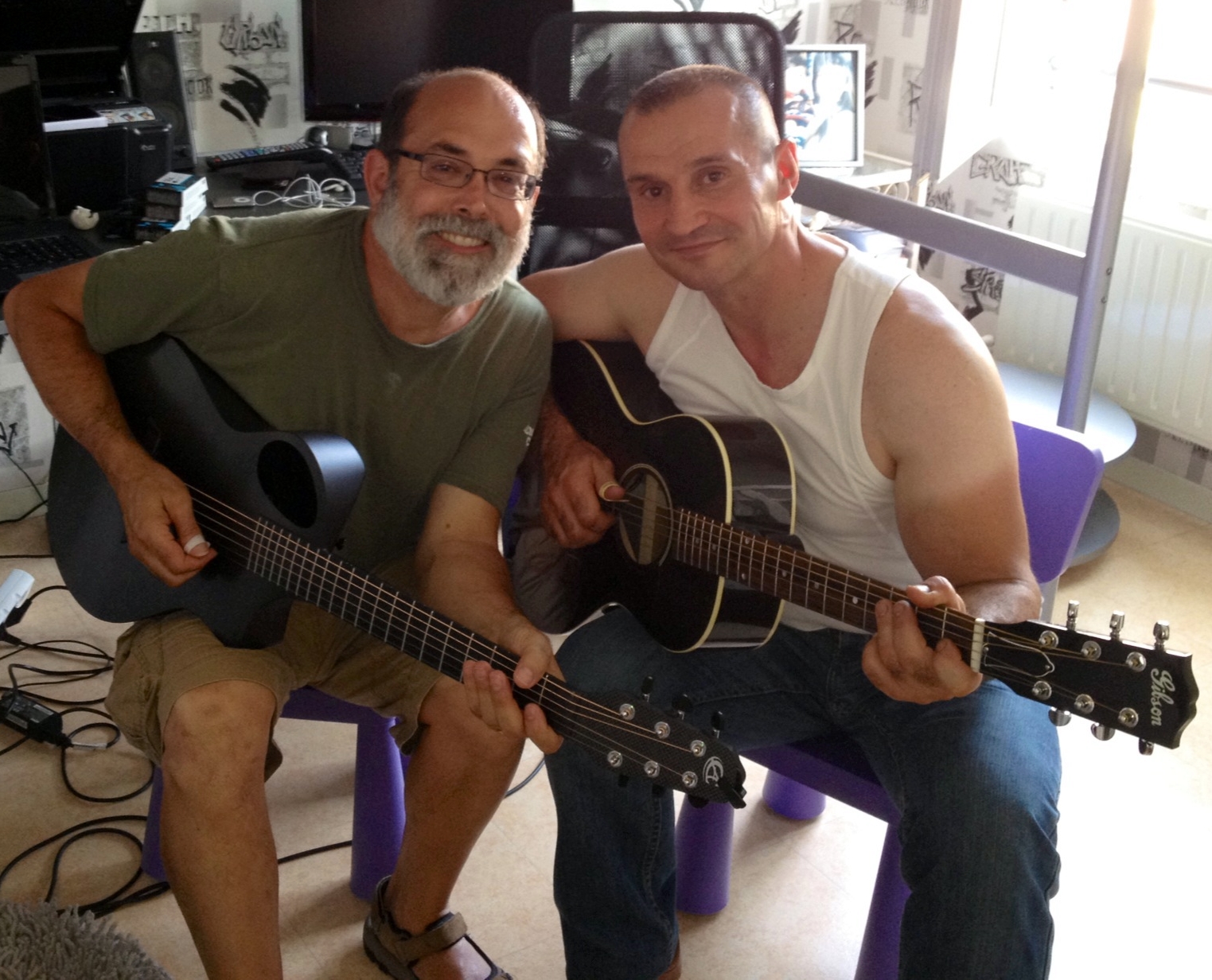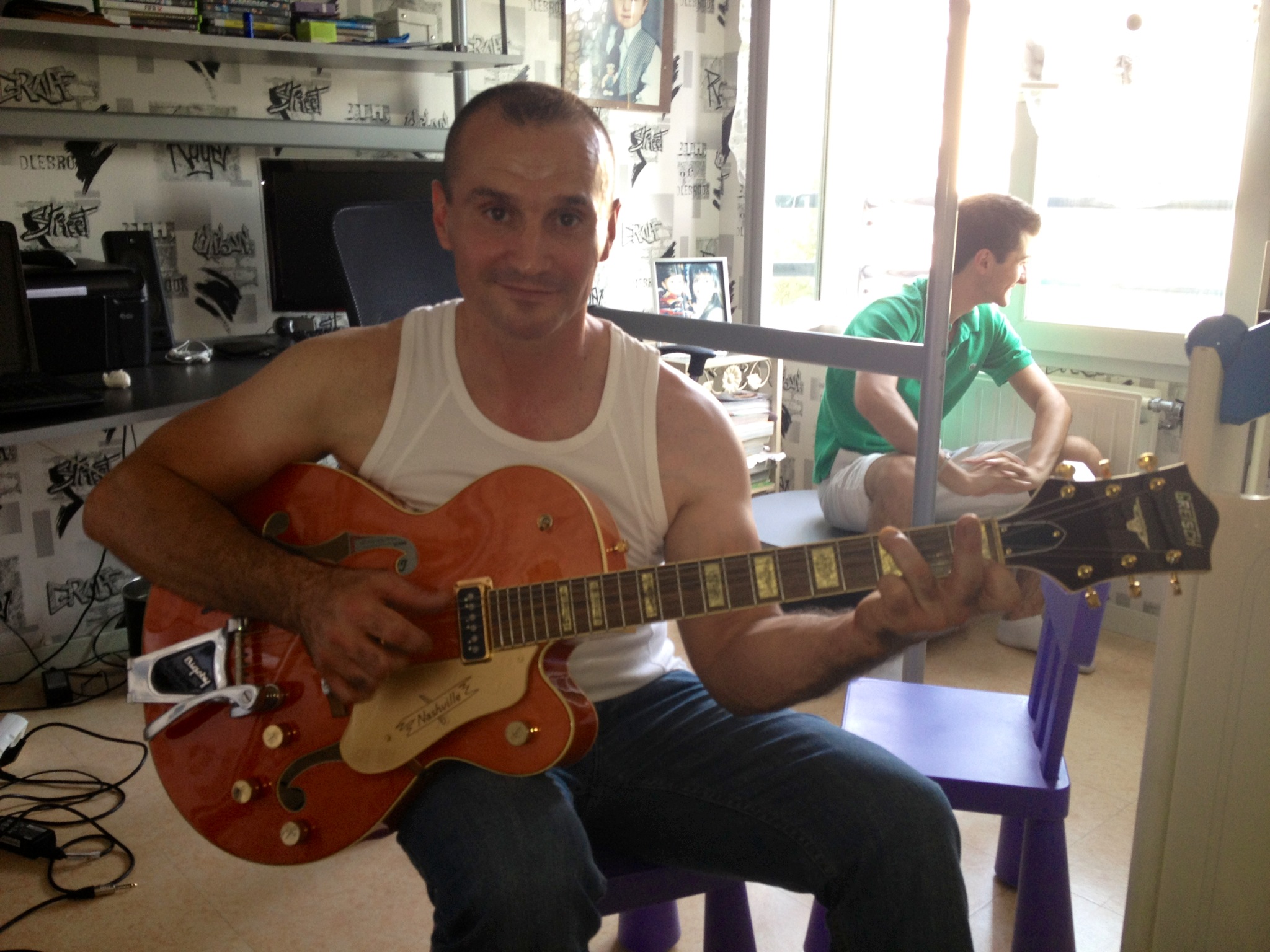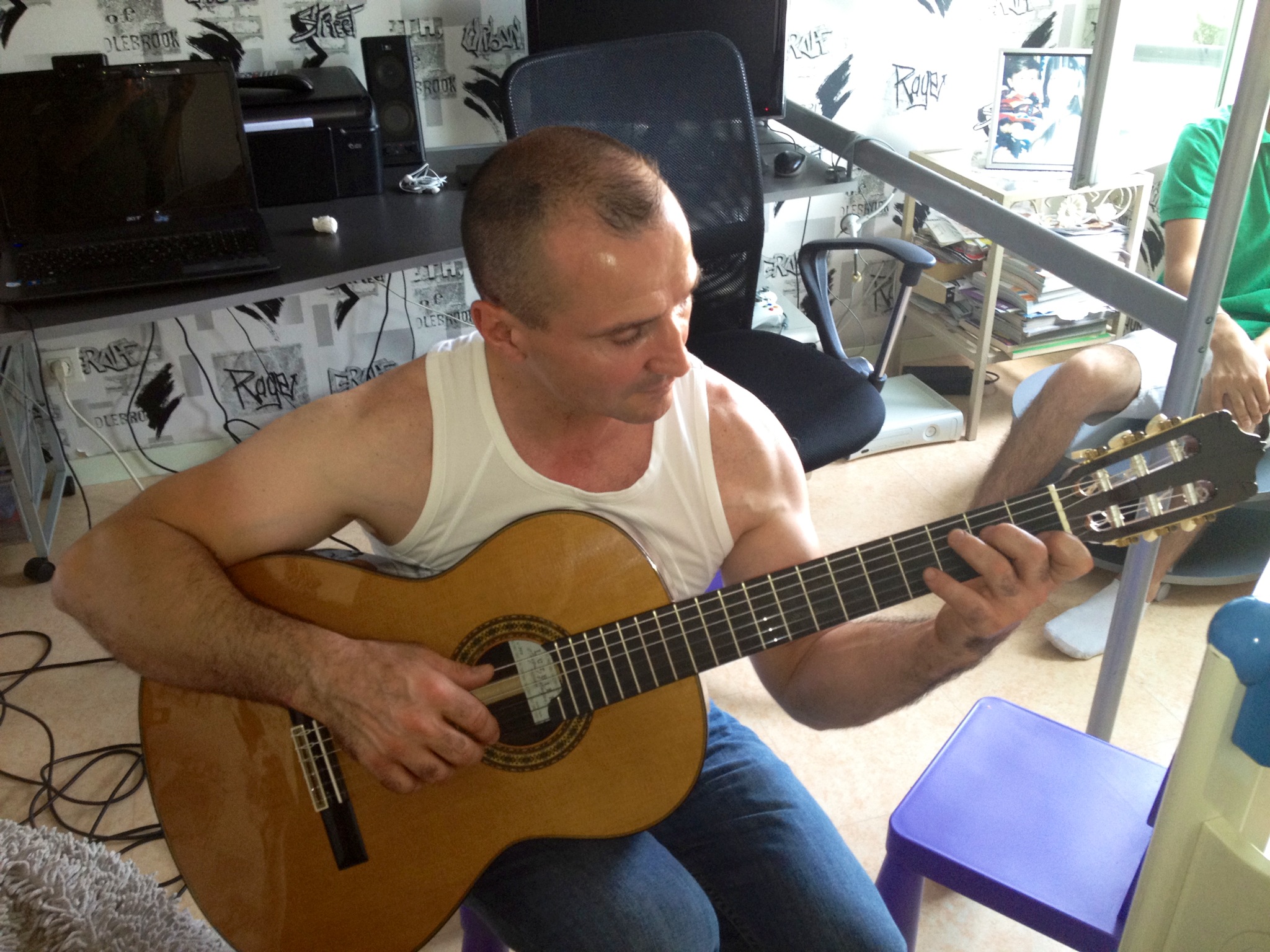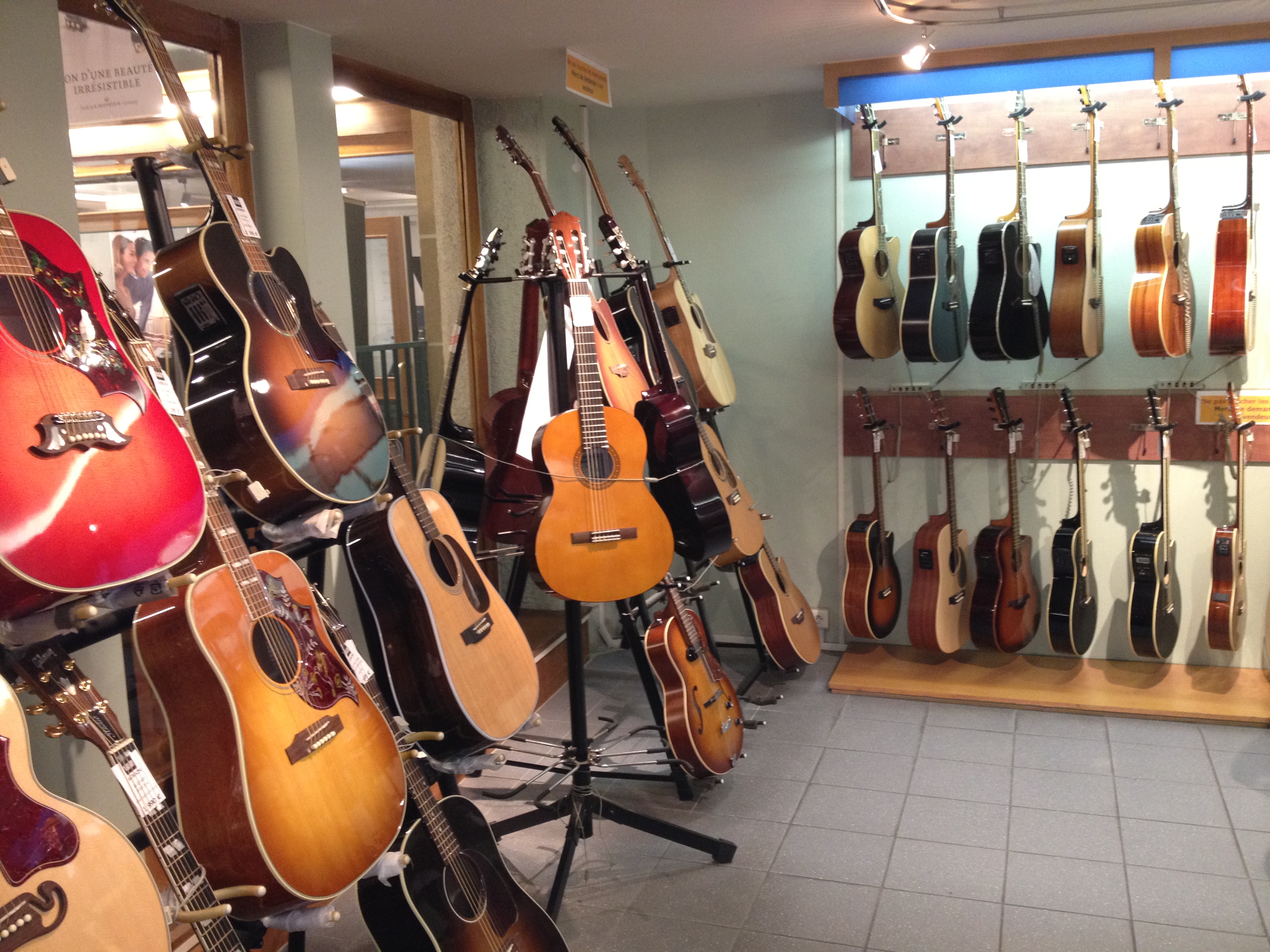So, is Henri here?
Not yet.
When was he supposed to be here?
Noon, a half an hour ago.
Have you called him?
I tried. But, my cell phone doesn’t seem to be working. I think that when I asked Verizon to turn off data roaming they turned off all international service.
Well, let’s just wait.
I had this conversation with my wife several days ago in Paris. We had just arrived from the States and were awaiting the availability of our hotel room. Our kids were sacked out in the hotel lobby and my wife would soon yield to the fatigue brought on by an overnight flight from New York. As for me? I would wait and worry about my friend Henri.
Henri had contacted me a few weeks earlier. He’d seen my YouTube demonstration of a circa 1920 Larson Brothers-built Maurer guitar and had been moved by the composition I played, John Pell’s “The Last Time I Saw Home.” It’s a lovely tune that I learned years ago from a transcription. Henri asked whether I had the transcription to share, but I confessed that I’d long ago misplaced it. “Well. If you’re ever in France,” wrote Henri, “I’d like to meet you.”
As fate would have it, I would be traveling with my family to France in a couple of weeks. So, Henri and I made plans to rendezvous in Paris, where I would show him how to play the tune. I reached out to John Pell, a prolific composer, founder and leader of Chet Atkins’s Nashville Guitar Quartet, and a music professor at Nashville’s Belmont University. Though a busy man, John was delighted at the possibility of having us Skype him into our meeting so that he could demonstrate some of the finer points of his composition.
Ah, but the best laid plans fell victim to technology and language differences. When I landed, my cell service carrier texted that I was beginning to run up a rather impressive bill for data roaming. Just the previous day, I’d carefully requested only voice services and not data services. So, I texted a request to turn off the data service. Alas, the minions on the other end of my text message simply turned off all service.
To complicate matters, I don’t speak French and Henri doesn’t speak English. We’d searched for and failed to find a common language (our closest match: Henri’s wife speakers Italian and I speak Spanish). So, we simply used Google translate in our missives. Unfortunately I made the fatal error of including too much information in my email messages: “We need to meet at X time in Paris so that Mr. Pell will be available at Y time in Nashville.” Run that back and forth through translation software a few times and the result will, and did, come to resemble what one gets via the children’s game of “telephone.” You know the one: each child in turn whispers a phrase to the next and the final child’s interpretation invariably differs dramatically from the original message.
Henri waited. I waited. We never met. Henri left Paris heartbroken and wondering during for the four plus hour drive to his home in Lyon whether this had been some sort of hoax. When I figured out what had happen, I, too, was saddened by our failure to connect and vowed to set things right before returning home.
It’s now a week later and I sit on a train traveling from Geneva to Lyon, where I will meet Henri for an afternoon of food, merriment, and, of course, guitar playing. As I watch the rolling hills and farmlands flash past the train window, my thoughts drift to the power of music and, in particular, to the power of John Pell’s quiet, sensitive, yet moving composition. A single song has bridged not only continents and a language barrier, but it has motivated us to leap the chasm created by the vagaries of modern communication methods. Playing the composition has brought me great pleasure over the years. I now stand, uh, make that sit, poised to have the composition open a whole new world to my embrace.
At about the halfway point to Lyon, the train stops in a small village and a couple of dozen college-aged backpackers board the train. I spot one young woman with a guitar strapped to her backpack and reflect back to my first journey to Europe several decades ago. When newly married, my wife and I bought Eurail Passes and rode the trains for two months. I didn’t carry a guitar, but was able to borrow one wherever the young congregated. In many ways, though I now travel with more creature comforts, few things have changed. Music still forms a central part of my cultural exploration.
As the train pulls into the Lyon Part-Deux Station an hour later, I grab my Composite Acoustics “Cargo” guitar (my constant traveling companion these days: it’s indestructible, plays great, sounds fine, and bears nothing resembling wood or other natural substances subject to CITES or other laws restricting the international movement of rare materials) and bounce down the train car steps. Henri and his step son, Adrian, step quickly through the crowd, we embrace, he says “hello” and I reply “bonjour” and though we thus exhaust our common verbal language, we know that music will speak for us this afternoon.
The moment we enter his car, Henri pops in a Marcel Dadi CD and begins to click through to his favorite tunes. “Marcel was the most famous guitarist in France,” says Henri. “He still is, really. His CDs still sell the most of any guitarist.” “Of course,” I reply when he asks me whether I’m familiar with Dadi. Indeed, it turns out, both Henri and I learned our Nashville finger picking repertoire from the man. As we wind our way through the crowded streets of Lyon, much to the amusement of Henri’s stepson, we both do a bit of air fingerpicking as we grin from ear to ear at the discovery of our common musical heritage.
Dadi had mastered the styles of Chet, Jerry, and Merle and spread their music throughout Europe via the transcriptions that accompanied his recordings. After becoming friends with Chet Atkins, Dadi began performing annually at the meeting of the Chet Atkins Appreciation Society (CAAS) in Nashville and fast became a crowd favorite. I first attended CAAS in 1997, the year after Dadi tragically perished in the ill-fated TWA flight 800 that crashed into the Atlantic after taking off from Nashville after the previous CAAS meeting. The community’s sense of loss was still palpable. Marcel Dadi had made an extraordinary impression in the land of fingerpicking.
Our first stop is a music store. As I leave the streets of Lyon and pass through the doorway, of the appropriately named “Guitar Shop,” I find myself in a shop that could be situated in the States. Guitars, picks, packs of strings, and capos line the walls much as in the mom and pop guitar shop near my own home. While Henri runs upstairs to pick up “a special order,” I grab a Gibson J-45 and play the John Loudermilk composition, “Windy and Warm.” When Henri returns, he shows off his prize: a book of the transcriptions of the music of Doc Watson. A common heritage, indeed.
Our next destination is lunch. As Henri has explains, Lyon is the epicenter of French cuisine. We walk down Rue des Marronniers, a quaint, cobblestone-street lined with restaurants, and stop at the D’Workshop, where Henri’s son, Benjamin, has served for five years as head chef. The owner greets and seats us, brings us bread and a cold beer that is very welcome on this warm summer afternoon, and asks me what I’d like to order. When I ask for his recommendation, he responds by asking whether I like local, French food (oui!) and seafood (oui, oui!). “OK, then,” he says, “I’ll bring you my favorite dish.” A few minutes later I find myself digging in to the finest meal I’ve encountered on this journey: perch encrusted in impossibly light pastry and cooked in a lobster sauce. This lunch, alone, would have been worth the two-hour journey from Geneva. C’est magnifique!
After lunch, we head to Henri’s apartment and get down to some guitar playing. First, of course, I ask to see Henri’s guitars and he begins by presenting his “baby,” a Gretsch 6120, just like Chet’s, complete with cowboy inlays and a Bigbsy vibrato. Can you say “Mr. Guitar”? Henri also brings out a couple of very nice classical guitars, a Gibson L-00 “Blues King,” and his Takmine jumbo.
Henri plugs the Takmine into a small amplifier and demonstrates that, well, it is I who should be taking lessons from him. He picks through several of Dadi’s compositions as well as some of the great French guitarist’s arrangements of Chet Atkins and Mere Travis tunes. I’m particularly taken with Henri’s rendition of Dadi’s “Song for Leo,” an homage to Leo Kotke, and ask Henri to show me how to play it. We spend a half an hour or so working through the tune until I’ve sort of got the hang of its basics. “OK,” I say, “now it’s my turn.”
This is a really moving moment for me. This one tune has spun a thread that crossed the Atlantic and has drawn me to the home of a man whom I’m certain will be a life-long friend. It’s a simple song that, like all simple compositions, hides its complexity in nuance. Pell has enriched the gorgeous, lilting melody with just hints at harmony presented through scraps of chords. The bass line is at times monotonic and at others arpeggiates through the lower strings, but never resolves into the alternating pattern of most Nashville-style fingerpicking. It is a tune that never fails to impress the listener and in its subtlety often confounds the most accomplished player.
Unfortunately, Pell is not able to join us via Skype: my last-minute victory in arranging my meeting with Henri hasn’t provided the composer with sufficient notice to arrange his schedule to join us virtually. But, I’d do e-chat with him later to describe my extraordinary experience of sitting in a musician’s living room in Lyon, France and communicating solely through “The Last Time I Saw Home.” “It gives me great pleasure to hear that others enjoy performing the piece,” says Pell. “I hope those who are learning it now find it a comfortable and rewarding friend as I have.”
The piece, in G6 tuning (DGDGBE), says Pell, altered his “understanding of what is most important between an artist and his audience”:
Playing with the fifth and sixth strings tuned down a whole step had significant advantages over standard tuning when in the key of G. I had worked up “Both Sides Now” and “Cancion Triste” in this tuning. Both tunes made use of the intervals of 3rds and 6ths on the upper strings. The bass parts of these tunes consisted mostly of open drone strings, allowing for great ease of movement in the left hand.
I explored with this tuning and the element of intervals when the piece quickly came together. Measure #10, with the harmonics, proved to be the only part of the tune that required some thought. Because it all came so quickly and easily, I tended to dismiss the piece, especially because I was young and associated difficulty with worthiness. I owe much to my good friend Joe Wise who would ask me to play a solo piece in the middle of his concerts. He liked “The Last Time I Saw Home” and preferred me to perform it over the more challenging tunes I suggested. Much to my surprise, the piece was enthusiastically received. It changed my understanding of what is most important between an artist and his audience.
Although I’m an educator by trade, I don’t think I’ve ever sat and attempted to teach someone a musical composition. And, although the physical aspect of this teaching effort — “OK, place your second and third fingers on the second fret of the fourth and fifth strings to fret A and E notes” (in G6 tuning) — distinguishes this from my usual activity of instructing law students, my time with Henri reinforces my belief that only by teaching something can one uncover some aspects of the topic taught. By breaking down Pell’s compositions into short phrases, I finally begin to appreciate the quality of the puzzle that is “The Last Time I Saw Home.”
As with working though “Song for Leo,” Henri and I hunch over two guitars and meet as one. Cultural, linguistic, and geographic differences melt away in the face of a common musical language and goal. As we master snippets of the tunes, we grin in gratitude and a feeling of commonality. We are brothers in musical implements.
The afternoon has all too quickly turned to evening and I must catch a train back to Geneva to rejoin family. As my train pulls up, Henri and I make a commitment to meet again as soon as possible. We also commit to two, parallel goals. I’ll learn some French and Marcel Dadi’s “Song for Leo;” Henri will learn (more) English and John Pell’s “The Last Time I Saw Home.”
As we part, Henri plies me with gifts. First, he pulls out a lovely bottle of vintage 2003 French wine. Then, he gives me a Marcel Dadi CD and the vinyl version of Dadi’s first record. I am overwhelmed. Then, to my surprise, he hands me that book of Doc Watson transcriptions. I’ve traveled to France, met a new friend, and received as a gift a bit of my own musical heritage. Music does, indeed, make the world go ‘round. Or, perhaps more accurately, people go around the world for music. At least, I do.
On my return journey to Geneva, I find myself barely noticing the pastoral images of the beautiful French countryside and reflecting, instead, on the gift that John Pell has given me. “The Last Time I Saw Home” has led me to the first time I saw Lyon and to a new home away from home.
Thank you, Mr. Pell. And, thank you, Henri, for making this experience possible.
Intrigued? Interested in deepening your understanding of the relationship between artist and audience? Here are links to a transcription of “The Last Time I Saw Home”: page one, page two, page three.
Au revoir.


Henri with his Gretsch

Henri with his classical guitar

Guitar Shop, 24 Rue Thomassin, Lyon, France